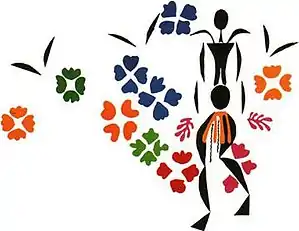La Négresse
La Négresse (1952–53) by Henri Matisse is a gouache découpée, made of cut pieces of colored paper.
| La Négresse | |
|---|---|
 | |
| Artist | Henri Matisse |
| Year | 1952–53 |
| Type | Cut paper painted with gouache |
| Dimensions | 453.9 cm × 623.3 cm (178 11/16 in × 245 3/8 in) |
| Location | National Gallery of Art, Washington, D.C. |
Medium
Starting in the 1930s, Matisse began to experiment with creating art by cutting paper into shapes. By 1950, he had primarily shifted to this mode of art making, perhaps because his health and disabilities made painting on a large scale difficult.[1] These "cut-outs" were often mural-sized and made from pieces of paper painted with gouache.[2]
La Négresse was first pinned onto the wall at his apartment in Nice, France around 1952.[3] He rearranged the composition until early 1953.[4] It takes up an entire wall. A newspaper review called the figure "a giantess."[5]
Subject or Inspiration

La Négresse may be inspired by Josephine Baker, a black American dancer whose popularity reached its height in Paris during the 1920s and 1930s.[4][6] One of Baker's famous outfits was a skirt made from bananas, which Matisse may be invoking in the orange-yellow forms around the figure's waist.[4][7] Baker's association with jazz music may have also inspired Matisse, whose had previously designed a book titled Jazz (1947).[3] Matisse's depiction has been criticized as reiterating "racialized clichés in the enlarged belly and hips."[7] Others have proposed that Matisse presented black women as beautiful.[8]
Other scholars propose that the figure may be of another famous dancer, Yvette Chauviré.[3] Matisse had created an earlier work about a dancer (Creole Dancer, 1950) that art critic Louis Aragon identified as Katherine Dunham, who Matisse had seen perform.[3][9] The work may also be an imagined dancer or amalgamation of the previously discussed figures.
Reception
The work has been praised as "the culmination of Matisse's art."[6] It was acquired by the National Gallery of Art in 1973.[10]
In 2018, the work was referenced in the title of Denise Murrell's exhibition and catalog Posing Modernity: the Black Model from Manet to Matisse.[8]
References
- "Henri Matisse" Archived 2008-08-04 at the Wayback Machine, Pompidou Centre. Retrieved 25 December 2007.
- "Henri Matisse: The Cut-Outs". Museum of Modern Art. Retrieved 2021-01-20.
- Cullinan, Nicholas (2014). "Chromatic Composition". Henri Matisse: the cut-outs. Buchberg, Karl D.; Cullinan, Nicholas; Hauptman, Jodi; Sirota, Nicholas; Friedman, Samantha; Frigeri, Flavia|. New York: The Museum of Modern Art. p. 196. ISBN 978-0-87070-915-9. OCLC 859305247.
- Hauptman, Jodi (2014). "Bodies and Waves". Henri Matisse: the cut-outs. Buchberg, Karl D.; Cullinan, Nicholas; Hauptman, Jodi; Sirota, Nicholas; Friedman, Samantha; Frigeri, Flavia. New York: The Museum of Modern Art. p. 196. ISBN 978-0-87070-915-9. OCLC 859305247.
- Richard, Paul (1977). "The Cutouts of Matisse: Seabirds, Ponies and Acrobats: Masterpieces from Scissors Seabirds and Ponies: The Designs of Matisse." The Washington Post, Sept. 9, 1977, B1, B11.
- Millard, Charles W. (1978). "The Matisse Cut-Outs". The Hudson Review. 31 (2): 326. doi:10.2307/3849913. ISSN 0018-702X.
- Wright, Alistair (Sept. 2014). "Henri Matisse: The Cut-Outs". Artforum International, 53, 370-371,12. "La Négresse, 1952–53, a work not in this show but inspired by the films of Josephine Baker, reiterates racialized clichés in the enlarged belly and hips and in the abstracted yellow form that represents Baker's notorious banana skirt. (In the catalogue, the curators celebrate Matisse's invention of a new visual sign for the skirt, but it is a sign utterly reliant on ready-made stereotypes.)"
- Murrell, Denise (2018). Posing modernity : the black model from Manet and Matisse to today. Wallach Art Gallery, Musée d'Orsay. New Haven: Yale University Press. ISBN 978-0-300-25764-9. OCLC 1161990675.
- Tompkins Lewis, Mary (December 3, 2018). "'Posing Modernity: The Black Model from Manet and Matisse to Today' Review: A Groundbreaking Look; an Exhibition at Columbia Includes Manet, Matisse, Bearden and Many Others." Wall Street Journal. ProQuest.
- "Henri Matisse, La Négresse, 1952". National Gallery of Art. Retrieved 2021-01-20.